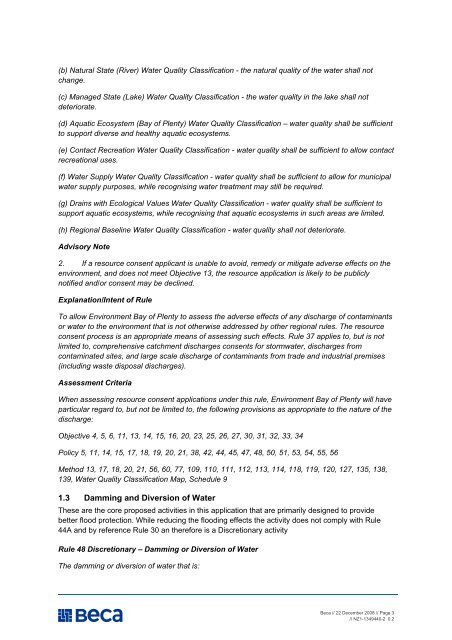2. Mangatawa catchment consents for earthworks, storm water ...
2. Mangatawa catchment consents for earthworks, storm water ...
2. Mangatawa catchment consents for earthworks, storm water ...
- No tags were found...
You also want an ePaper? Increase the reach of your titles
YUMPU automatically turns print PDFs into web optimized ePapers that Google loves.
(b) Natural State (River) Water Quality Classification - the natural quality of the <strong>water</strong> shall not<br />
change.<br />
(c) Managed State (Lake) Water Quality Classification - the <strong>water</strong> quality in the lake shall not<br />
deteriorate.<br />
(d) Aquatic Ecosystem (Bay of Plenty) Water Quality Classification – <strong>water</strong> quality shall be sufficient<br />
to support diverse and healthy aquatic ecosystems.<br />
(e) Contact Recreation Water Quality Classification - <strong>water</strong> quality shall be sufficient to allow contact<br />
recreational uses.<br />
(f) Water Supply Water Quality Classification - <strong>water</strong> quality shall be sufficient to allow <strong>for</strong> municipal<br />
<strong>water</strong> supply purposes, while recognising <strong>water</strong> treatment may still be required.<br />
(g) Drains with Ecological Values Water Quality Classification - <strong>water</strong> quality shall be sufficient to<br />
support aquatic ecosystems, while recognising that aquatic ecosystems in such areas are limited.<br />
(h) Regional Baseline Water Quality Classification - <strong>water</strong> quality shall not deteriorate.<br />
Advisory Note<br />
<strong>2.</strong> If a resource consent applicant is unable to avoid, remedy or mitigate adverse effects on the<br />
environment, and does not meet Objective 13, the resource application is likely to be publicly<br />
notified and/or consent may be declined.<br />
Explanation/Intent of Rule<br />
To allow Environment Bay of Plenty to assess the adverse effects of any discharge of contaminants<br />
or <strong>water</strong> to the environment that is not otherwise addressed by other regional rules. The resource<br />
consent process is an appropriate means of assessing such effects. Rule 37 applies to, but is not<br />
limited to, comprehensive <strong>catchment</strong> discharges <strong>consents</strong> <strong>for</strong> <strong>storm</strong><strong>water</strong>, discharges from<br />
contaminated sites, and large scale discharge of contaminants from trade and industrial premises<br />
(including waste disposal discharges).<br />
Assessment Criteria<br />
When assessing resource consent applications under this rule, Environment Bay of Plenty will have<br />
particular regard to, but not be limited to, the following provisions as appropriate to the nature of the<br />
discharge:<br />
Objective 4, 5, 6, 11, 13, 14, 15, 16, 20, 23, 25, 26, 27, 30, 31, 32, 33, 34<br />
Policy 5, 11, 14, 15, 17, 18, 19, 20, 21, 38, 42, 44, 45, 47, 48, 50, 51, 53, 54, 55, 56<br />
Method 13, 17, 18, 20, 21, 56, 60, 77, 109, 110, 111, 112, 113, 114, 118, 119, 120, 127, 135, 138,<br />
139, Water Quality Classification Map, Schedule 9<br />
1.3 Damming and Diversion of Water<br />
These are the core proposed activities in this application that are primarily designed to provide<br />
better flood protection. While reducing the flooding effects the activity does not comply with Rule<br />
44A and by reference Rule 30 an there<strong>for</strong>e is a Discretionary activity<br />
Rule 48 Discretionary – Damming or Diversion of Water<br />
The damming or diversion of <strong>water</strong> that is:<br />
Beca // 22 December 2008 // Page 3<br />
// NZ1-1349440-2 0.2
















